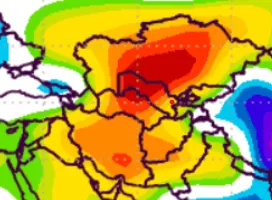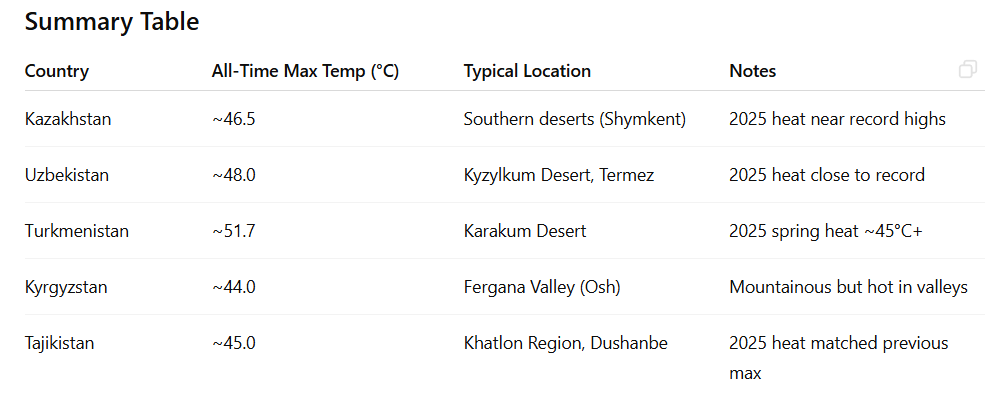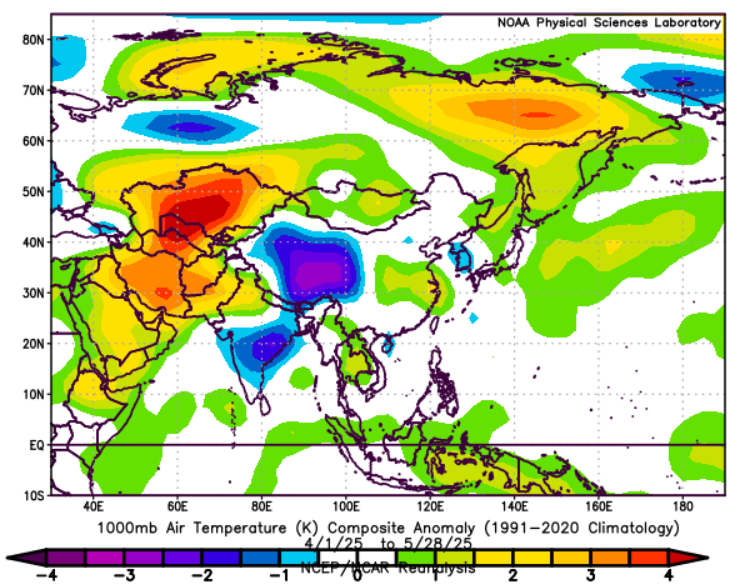
In spring 2025, Central Asia (Kazakhstan, Uzbekistan, Turkmenistan, Kyrgyzstan, Tajikistan)—experienced unprecedented heatwaves that shattered temperature records and caused widespread concern.
April 2025: Early Season Heatwave and Record-Breaking Temperatures
- Exceptional April warmth swept the region, with many areas seeing temperatures exceeding 10 to 15°C above average for the month.
- Some locations recorded April temperatures normally only seen in mid-summer. For instance:
- Turkmenistan’s capital Ashgabat saw highs around 43–44°C, breaking long-standing April records.
- Uzbekistan experienced temperatures up to 42–43°C, far surpassing previous April norms.
- Kazakhstan recorded unusual warmth with readings around 38–40°C in southern regions, a rarity for April.
- This extreme spring heatwave was fueled by a persistent high-pressure system coupled with dry conditions, amplifying solar heating and suppressing rainfall.
- Such warmth so early in the year disrupted natural cycles, affecting agriculture with premature plant stress and early soil drying.
May 2025: Intensified and Extended Heatwave Across the Region
The heatwave intensified in May, with multiple all-time May temperature records broken: Turkmenistan reached a blistering 45.6°C — one of the highest May temperatures ever recorded in the country. Uzbekistan peaked at 44.5°C, setting new May records in several southern cities. Kazakhstan’s southern provinces reported extreme highs near 44.0°C, far exceeding historical May data. Kyrgyzstan and Tajikistan also recorded unseasonably high temperatures in the low 40s Celsius, breaking local May records.
How are all-time highs for Summer?

Impacts on Environment, Society, and Economy
- Agriculture: Early and intense heat caused drought stress on winter and spring crops, with significant risk to wheat, barley, and cotton yields in Kazakhstan, Uzbekistan, and Turkmenistan.
- Water Resources: Rapid snowmelt combined with low precipitation increased water demand and stress, heightening risks of shortages during the peak summer months.
- Public Health: The sudden onset of extreme heat exposed vulnerable populations to heat stress and increased the incidence of heat-related illnesses.
- Infrastructure: Increased electricity demand for cooling strained power grids, while roads and rail infrastructure faced thermal expansion and damage risks.
- Wildfires: Dry and hot conditions contributed to a heightened wildfire risk, especially in Kazakhstan and southern Siberia.
Climate Context and Outlook
- Meteorologists emphasize that these heatwaves are consistent with climate change projections of more frequent and intense extreme heat events in Central Asia.
- The pattern of persistent high pressure and dry conditions is becoming more common in spring, extending the heat season.
- Forecast models for summer 2025 predict continued above-average temperatures, suggesting further challenges ahead for water management, agriculture, and public health.
- There is a growing need for adaptation measures, including improved heat warning systems, drought-resistant crops, and infrastructure reinforcement.

April and May in Asia so far (air temperature anomaly). Source: https://psl.noaa.gov/data/composites/day/


























